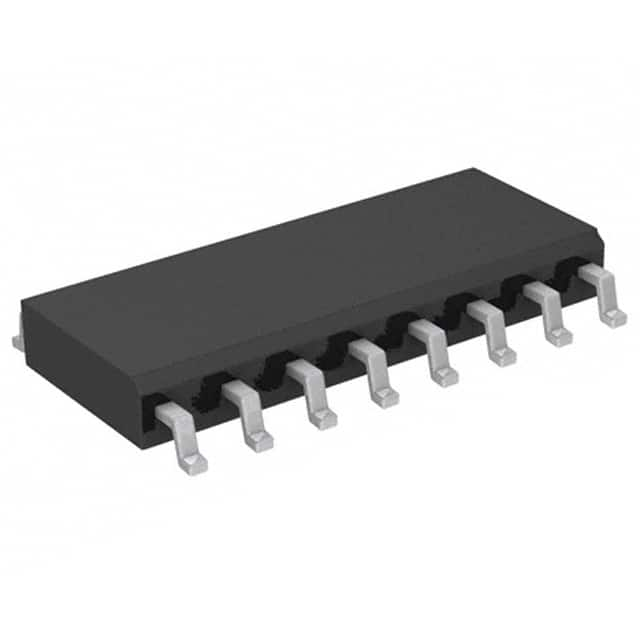Consulte las especificaciones para obtener detalles del producto.

MM74HCT138M
Product Overview
- Category: Integrated Circuit (IC)
- Use: Decoder/Demultiplexer
- Characteristics: High-Speed CMOS Logic, 3-to-8 Line Decoder/Demultiplexer
- Package: SOIC (Small Outline Integrated Circuit)
- Essence: The MM74HCT138M is a decoder/demultiplexer IC that converts a binary input into one of eight outputs.
- Packaging/Quantity: Available in reels of 2500 pieces
Specifications
- Supply Voltage: 2V to 6V
- Input Voltage: 0V to Vcc
- Output Voltage: 0V to Vcc
- Operating Temperature: -40°C to +85°C
- Propagation Delay: 15ns (typical)
- Output Current: ±25mA
Pin Configuration
The MM74HCT138M has a total of 16 pins. Here is the detailed pin configuration:
- GND (Ground)
- A0 (Binary Input 0)
- A1 (Binary Input 1)
- A2 (Binary Input 2)
- /G1 (Enable Input)
- Y0 (Output 0)
- Y1 (Output 1)
- Y2 (Output 2)
- Y3 (Output 3)
- Y4 (Output 4)
- Y5 (Output 5)
- Y6 (Output 6)
- Y7 (Output 7)
- Vcc (Positive Power Supply)
- /G2A (Enable Input)
- /G2B (Enable Input)
Functional Features
- Converts a 3-bit binary input into one of eight active-low outputs
- Enable inputs allow for easy cascading of multiple ICs
- High-speed operation with low power consumption
- Compatible with TTL and CMOS logic levels
Advantages and Disadvantages
Advantages: - Fast propagation delay ensures quick response time - Low power consumption makes it suitable for battery-powered devices - Can be easily cascaded to create larger decoder/demultiplexer circuits
Disadvantages: - Limited to 3-bit binary input, restricting the number of possible combinations - Requires external pull-up resistors for proper operation
Working Principles
The MM74HCT138M works based on the principle of decoding a binary input into one of eight outputs. The three binary inputs (A0, A1, and A2) determine which output line is activated. The enable inputs (/G1, /G2A, and /G2B) control the overall functioning of the IC.
When the enable inputs are active (low), the selected output line goes low, while all other output lines remain high. The propagation delay is minimal, ensuring quick response time.
Detailed Application Field Plans
The MM74HCT138M finds applications in various fields, including:
- Address Decoding: Used in microcontrollers and memory systems to select specific addresses.
- Data Demultiplexing: Enables the distribution of data from a single source to multiple destinations.
- Digital Circuit Design: Forms an essential component in designing complex digital circuits.
- Programmable Logic Controllers (PLCs): Facilitates control signal routing in PLCs.
Detailed and Complete Alternative Models
- 74HC138: Similar functionality but operates at a wider supply voltage range (2V to 6V).
- CD74HCT138E: Equivalent IC with identical pin configuration and characteristics.
- SN74HCT138N: Alternative model from Texas Instruments with comparable specifications.
These alternative models can be used as substitutes for the MM74HCT138M, depending on specific requirements and availability.
In conclusion, the MM74HCT138M is a high-speed CMOS decoder/demultiplexer IC that converts a 3-bit binary input into one of eight outputs. Its compact SOIC package, low power consumption, and compatibility with TTL and CMOS logic levels make it suitable for various digital circuit applications. However, its limited input capacity and requirement for external pull-up resistors are notable considerations.
Enumere 10 preguntas y respuestas comunes relacionadas con la aplicación de MM74HCT138M en soluciones técnicas
Sure! Here are 10 common questions and answers related to the application of MM74HCT138M in technical solutions:
Q: What is MM74HCT138M? A: MM74HCT138M is a 3-to-8 line decoder/demultiplexer integrated circuit (IC) commonly used in digital electronics.
Q: What is the purpose of MM74HCT138M? A: The purpose of MM74HCT138M is to decode a binary input and activate one of the eight output lines based on the input value.
Q: What voltage levels does MM74HCT138M support? A: MM74HCT138M supports TTL-compatible input voltage levels and operates at a supply voltage range of 4.5V to 5.5V.
Q: How many inputs does MM74HCT138M have? A: MM74HCT138M has three binary inputs (A, B, and C) that can be used to select one of the eight output lines.
Q: Can MM74HCT138M be cascaded to increase the number of outputs? A: Yes, multiple MM74HCT138M ICs can be cascaded together to increase the number of outputs for larger applications.
Q: What is the maximum output current of MM74HCT138M? A: The maximum output current of MM74HCT138M is typically around 4mA.
Q: Can MM74HCT138M drive LEDs directly? A: Yes, MM74HCT138M can drive LEDs directly as long as the total current drawn by all the LEDs does not exceed the maximum output current.
Q: Does MM74HCT138M have any built-in protection features? A: MM74HCT138M has built-in diode clamps on the inputs to protect against static discharge and overvoltage conditions.
Q: What is the propagation delay of MM74HCT138M? A: The propagation delay of MM74HCT138M is typically around 15ns, which means it takes approximately 15 nanoseconds for the output to respond to a change in input.
Q: Can MM74HCT138M be used in both synchronous and asynchronous applications? A: Yes, MM74HCT138M can be used in both synchronous and asynchronous applications depending on the specific requirements of the circuit.
Please note that these answers are general and may vary depending on the specific datasheet and manufacturer's specifications of MM74HCT138M.

